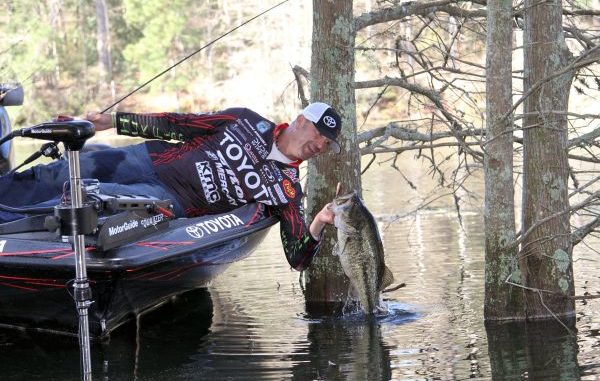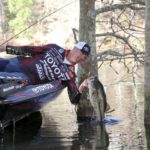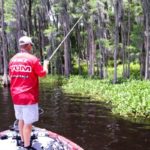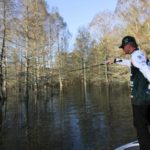
Pick out the best trees in these flooded forests to build hefty stringers of bass — even when summer temperatures top out.
It’s the mall food court — the beach umbrella with that cooler full of snacks. For bass, we’re talking about cypress trees.
Stoic and steady, this classic Southern lake habitat presents an enchanting and ever-beckoning realm where, despite the occasional moccasin, bass anglers can typically expect to pass a good time.
Shade and food — that’s the formula that makes cypress swamps one of your cool options during summer’s heat.
And, as Bassmaster Elite Series pro Cliff Prince noted, the forever-wet trees play particularly relevant roles in areas where deep water stands distant.
“A lot of Louisiana lakes with cypress swamps don’t have much depth, so you look for where the bait is going,” Prince said. “Whatever the fish are feeding on, whether it’s baitfish, crawfish, bream or whatever, the cypress trees offer a perfect place for those things to hide.
“So obviously, the fish are going to go there to feed.”
In tidal waters like the Atchafalya Basin, fish will reposition relevant to water levels, but inland lakes find more consistent positioning throughout the day.
However, while the cypress attraction remains consistent, Prince knows fish will still display various levels of aggression with changing light and heat levels.
“In shallow lakes, cypress trees can be productive all day long, but in the morning you might get a topwater bite and then as the sun gets up you might be fishing the shady sides of the trees,” he said. “And then, in the afternoon, you might go back to picking them off with topwaters.”
Cypress tress sitting along the edges of a cut or channel benefit from the dynamics of nearby deeper water, but those tucked way back by their lonesome offer bass the seclusion they favor.
Bottom line: There aren’t many unattractive cypress trees.
That being said, Prince stresses the importance of learning to look with discerning eyes.
“When I start fishing a set of cypress trees, I pay attention to the first bite I get,” Prince said. “Was it on an inside tree, an outside tree? Was it back in shade? Was it in deeper water? Does it have an extensive root system?
“I want to know what makes that tree different from the other 500 trees on that bank. Was it an isolated tree that sits on a point? How much shade does that tree get? I try to figure out why the fish was hanging out on that particular tree so I can look for more like that one.”
Toledo Bend guide Darold Gleason said cypress trees alone offer plenty of opportunity; however, when secondary cover exists, he knows he’s found some serious rod-bending potential.
“I focus on clumps of trees on points, and especially target trees with clumps of hydrilla or hyacinth mats around them,” Gleason said. “This just adds more shade and protection for the bass.
“Also the bluegill and crawfish will hide around this cover.”
Now, survey a large stand of cypress trees and you’ll quickly pick out a handful of gotta-try spots.
But hold on: Don’t rush the scene. This isn’t like chasing schooling bass that are here and gone in a matter of seconds.
Bass hugging their cypress condos are your homebodies that aren’t moving anytime soon. So pace yourself and maximize the opportunity.
“I start with whatever appeals to me on the perimeter, and then work my way back into the cypress swamp where I’ll try to figure out what the fish like that day,” Prince said. “You always want to start on the outside so you don’t miss any opportunities on your way inside.”





